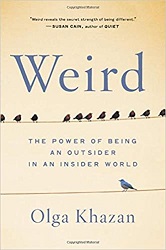What We're Reading Now
Embrace your Weirdness
3 August 2021
Janie read Weird: The Power of Being an Outsider in an Insider World by Olga Khazan and appreciated her suggestions for handling social situations. Turns out that we all feel a little weird sometimes.
Tags: covid-19, janie read
Now that we’re in the in-between times, I notice that I have a lot of mixed feelings about being with people in person again. Sometimes, I’m excited and I thoroughly enjoy being around other humans. Other times, I feel a bit awkward or a comment hits me differently and I find myself ruminating over an interaction, rather than just letting it go.
I’ve been thinking about this conundrum recently and found some helpful suggestions in a somewhat unexpected place. I expected to enjoy reading Weird: The Power of Being an Outsider in an Insider World by Olga Khazan because the book blurbs indicated that it would include interesting stories and might have some suggestions that I could put into practice to help people feel more included in some of the community organizations I help lead. I was pleasantly surprised – not only were those things true, but some of Khazan’s own experience gave me insight into why I might be dwelling on things a bit more these days. More importantly, she suggested something to do about it.

Khazan writes about how weirdness often comes with significant social anxiety and imposter syndrome—the feeling that everyone else “belongs” and you don’t fit in. Khazan shared that this feeling is something she has always grappled with, and she decided to experiment with an app called Joyable to help her curb her anxious thoughts. The app required Khazan to share an anxious thought or “cognitive distortion” (e.g., X person hates me) and then follow that up with a more reasonable explanation (e.g., they were just busy, that’s why they were short with me). One of the cognitive distortions Khazan shared is personalizing—taking situations that have nothing to do with you and making them all about you. Khazan learned how to use a process known as the “three Cs” to step back and calm down a bit.
- Catch the thought that’s making you anxious
- Check that thought
- Change the thought to something that’s more “accurate” (and less anxiety inducing)
This process is similar to other methods of calming anxious thoughts, but I’ve found that the “three C” approach is very easy for me to remember. After reading Khazan’s examples, I realized that I often personalize situations and comments as well and thought it might be helpful to challenge myself to use the “three Cs” process.
I’ve found that using this process has been really helpful when I’ve found myself fixated on a comment or an interaction. For me, recognizing that the initial anxious thought is coming from my anxiety brain (and is not rooted in reality) helps keep me from personalizing it and then it’s much easier to let things go and enjoy time with others. As things open back up and we all work to find our way in the world again, I imagine that I’ll have lots of opportunities to practice catching, checking, and changing my thoughts. What about you?







Comments
Our Comment Policy:
Our blog posts are only half of the conversation. What our readers have to say is equally important to us, and we're grateful for all the comments that continue the dialog.
To ensure that the discussion here is as useful as possible to all of our readers, please be respectful of our contributors and refrain from harassing, threatening and/or vulgar language. We reserve the right to screen and remove any comments from the site. If you have a question about a comment or want to discuss our policy, please contact us. We'll talk it over.
There are no comments for this entry yet.